Nevada
Students connect to nature in Lake Tahoe through experiential classwork | University of Nevada, Reno

The University of Nevada, Reno at Lake Tahoe’s Wayne L. Prim Campus, nestled in the mountains and surrounded by pines, provides researchers, faculty and students with a vast outdoor laboratory that brings coursework to life. Many classes at the University’s Lake Tahoe campus, like Chris Smith’s Ecology and Population Biology class, allow students to learn from faculty currently researching the area, and to have access to an ecosystem that helps them forge tangible connections to the material from their textbooks.
Smith has taught courses at the University of Nevada, Reno at Lake Tahoe since 2020, primarily focusing on ecology, natural history and statistics. During his time on campus, he has developed a curriculum that elevates his coursework by bringing course material to life through experiential learning in outdoor labs and trips. This semester, Smith’s Ecology and Population Biology class brought students outdoors on various occasions. During the field day trips, students observed the ecology of Taylor Creek in South Lake Tahoe during the annual Kokanee Salmon spawning, for example, and took a deeper look at snowflake structure, snowpack and avalanche science, wildlife adaptations to winter in Tahoe Meadows, and measured old-growth trees and tree rings on stumps in Mount Rose Meadows to understand their history and record climate change impact on stumps.
“I’ve seen the field components really have an enormous impact on students,” said Smith, “We read about these things in textbooks, but we actually experience them and have connections and interactions with them. It makes that material come to life for students – not only do they remember it better, but they take away a personal connection to that experience.”
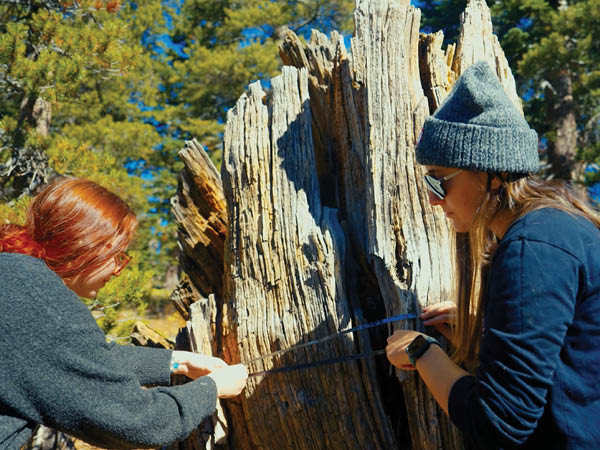
During a fall field course, he and his students drove up to Mount Rose Meadows to take an in-depth look at the ecology of the region and used information gathered during the lab to study historical impacts on the region and what it means for the future of the forest.
“150 years ago, all of most of the Lake Tahoe Basin was cut over for the mining over in Virginia City,” Smith said, “They left a few stumps, and it’s possible for us to go back and measure the diameter of these stumps to reconstruct the structure of the old forests. We can then compare the current structure of the forest 150 years later in our present day, to see if they have recovered to the point where they were 150 years ago.”
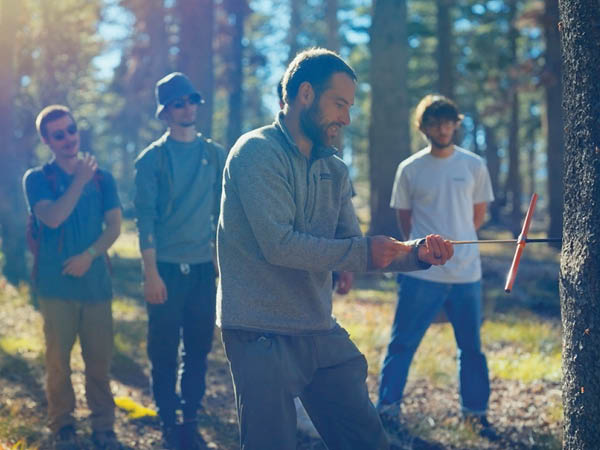
The group also visited a high-elevation meadow under threat from climate change.
“During the lab, we talked about succession and trees starting to invade these open grassy spaces that are often wetter, and with climate change drying things out and changing winter conditions, lodgepole pine trees especially are moving into these areas. It’s easy to drive past the meadow and not pay attention to it at all. But when you stop and look, you can see these trees that are slowly moving into the middle of the meadow, and maybe in 100 years, many of these meadows may not be here. It’s cool to be able to see that and talk about it and open students’ eyes to maybe something they’ve been seeing for years of their lives.”
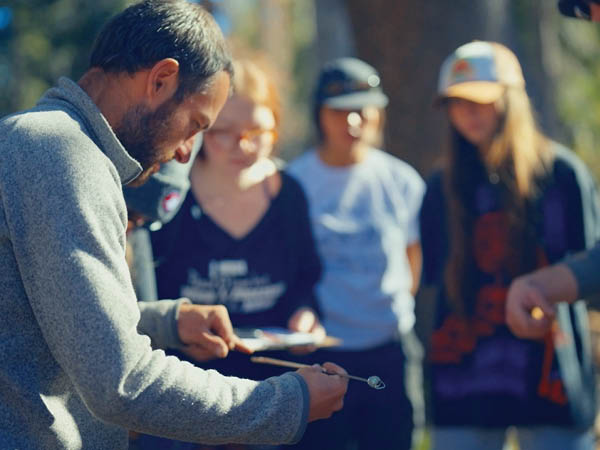
Smith’s courses provide more than just hands-on class content; getting students out into the field is also paramount in creating a connection between students and the area, promoting environmental stewardship and a love for the region. This connection, Smith states, develops a passion for the land and the area that drives students to care about the environment.
“My hope is that the coursework in my classes gives students a connection to Lake Tahoe that ultimately gives back to the health of the lake,” Smith said, “When students care about a place and form a personal connection with it, they naturally want to take care of it. In all my courses, I hope to create a connection so that students gain a deeper appreciation of what’s around them, and my hope is to show how important the health of Lake Tahoe is.”
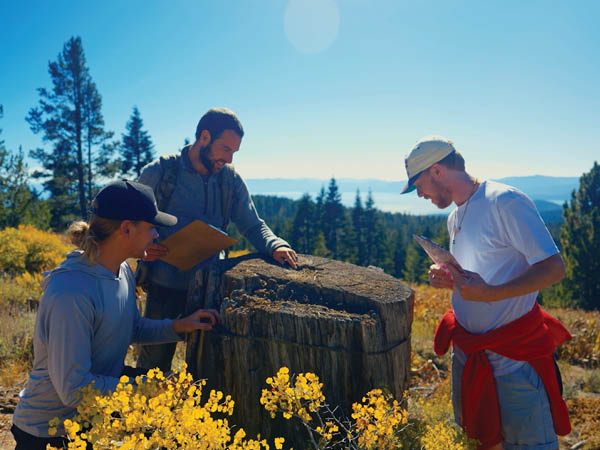
Smith’s course, like many courses at the Lake Tahoe campus, offers an unmatched experience for all students, breaking the boundary between disciplines to focus on interdisciplinary collaboration with coursework, projects and research that focus on the lake.
With classes and coursework modeled after the United Nations Sustainable Development Goals, students can earn a Sustainability Certificate while honing in on skills in their field with knowledge that aims to protect the environment through practice and thoughtful communication. To fill out an interest form for a semester at Tahoe or to learn more, visit the University of Nevada, Reno at Lake Tahoe website.
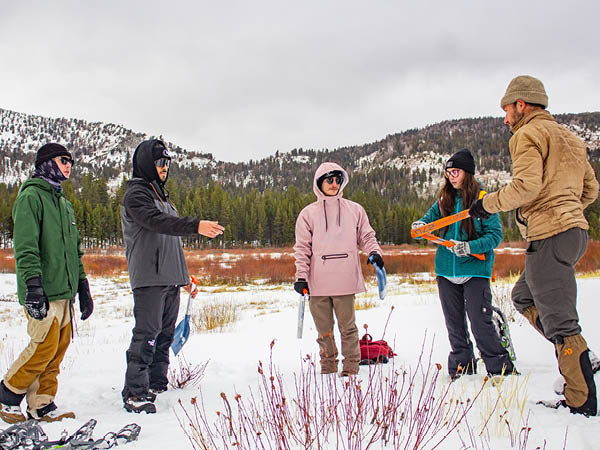
About the University of Nevada, Reno at Lake Tahoe
Located less than one mile from the shoreline of Lake Tahoe, the University of Nevada, Reno at Lake Tahoe’s Wayne L. Prim Campus merges experiences across education, research, creative and scholarly work in a stunning mountain environment. Beginning Fall 2024, undergraduate students are invited to earn their Certificate in Sustainability during a single-semester program that will incorporate outdoor and experiential learning into the coursework. Events and activities throughout the semester encourage a deep sense of community while inspiring environmental stewardship of the Lake Tahoe Basin and all our planet’s most precious natural resources.
In addition to its education offerings, the campus offers a robust program of community events and private conferences, welcoming the brightest minds in science, art and sustainability to Lake Tahoe.
The 18-acre setting in Incline Village includes 10 classrooms, several meeting/conference rooms, both large and medium events spaces, a cafeteria and catering service, highly equipped laboratories, 88 dorm rooms and the Lou Sardella Student Commons Lawn. The natural setting provides a living laboratory and serves as creative inspiration for both scientists, artists and students alike.

Nevada
Nevada basketball: How to watch Nevada at Fresno State on Saturday
After a challenging start to conference play, the Nevada basketball team has a chance to pick up its first win of the season in the Mountain West on Saturday.
But so does Fresno State.
The Wolf Pack plays the Bulldogs with tip-off set for 4 p.m. Saturday.
Nevada is 0-4 in conference (8-7 overall) and coming off a one-point overtime loss, 82-81, at New Mexico. The Bulldogs (4-12, 0-5 MW) lost by 27 at Colorado State, 91-64, on Tuesday
What time is the Nevada-Fresno State game at Save Mart Center?
Saturday, 4 p.m. in Fresno, California.
What TV channel and radio station are airing the Nevada-Fresno State game?
The game will be broadcast on TV on KNSN (Ch. 21) and on the Mountain West Network. It will be on the radio at 95.5 FM with John Ramey. All games are available online through the Varsity Network app.
The rankings
Nevada is No. 59 in the current KenPom Rankings, while Fresno State is No. 264.
Meanwhile, Nevada is No. 53 in the NCAA NET rankings and Fresno State is No. 273.
Scoring
Nick Davidson leads the Wolf Pack at 15.3 points per game and Kobe Sanders is averaging 15.1.
The Bulldogs have five players averaging double figures, led by Amar Aguillard at 13.3 points per game and Zaon Collins at 12.9.
Mountain West Standings
Conference, overall
- Utah State 5-0, 15-1
- New Mexico 5-0, 13-3
- Boise State 4-1, 12-4
- San Diego State 3-1, 10-3
- UNLV 3-1, 9-6
- Colorado State 3-1, 9-6
- Wyoming 2-3, 9-7
- Nevada 0-4, 8-7
- Air Force 0-4, 3-12
- San Jose State 0-5, 7-10
- Fresno State 0-5, 4-12
Saturday’s games: Nevada at Fresno State, San Diego State at New Mexico, San Jose State at Air Force, UNLV at Colorado State, Boise State at Utah State.
Nevada’s Schedule
- Jan. 11, Nevada at Fresno State, 4 p.m. (TV: KNSN, Radio: 95.5 FM)
- Jan. 14, Air Force at Nevada, 7 p.m. (TV: KNSN, Radio: 95.5 FM)
- Jan. 18, San Jose State at Nevada, 3 p.m.
- Jan. 22, Nevada at Utah State, 6 p.m.
- Jan. 25, Nevada at San Diego State, 7 p.m.
- Jan. 29, Nevada at Boise State, 7 p.m.
- Feb. 1, UNLV at Nevada, 8 p.m.
- Feb. 4, Nevada at Air Force, 6 p.m.
- Feb. 10, Fresno State at Nevada, 8 p.m.
- Feb. 14, Nevada at San Jose State, 7 p.m.
- Feb. 18, Nevada at Colorado State, 6 p.m.
- Feb. 22, Boise State at Nevada, 3 p.m.
- Feb. 25, Wyoming at Nevada, 7 p.m.
- Feb. 28, Nevada at UNLV, 8 p.m.
- March 4, New Mexico at Nevada, 6 p.m.
- March 8, Nevada at San Diego State, 7:30 p.m.
Nevada
Lt. Gov. Anthony forms task force to bar trans athletes in women’s sports

Nevada’s lieutenant governor formed a task force this week aimed at preventing transgender women and girls from participating in women’s sports and exploring how to create fair competition for the sexes.
Reached by phone Friday, Republican Stavros Anthony said he formed the “Lieutenant Governor’s Task Force to Protect Women’s Sports” to address what he described as potential unfairness from women and girl’s playing in athletic competitions against transgender female athletes.
“I wanted a very focused laser beam working together approach in the state of Nevada to make sure that we ban biological men playing in women’s sports,” he said.
Anthony said he didn’t know how many trans athletes play in Nevada, but he has “been told” that there are high school and college players. He said he didn’t believe the effort was wading into “transgender issues.” Instead, he said the task force is focused on biological sex.
The purpose of the task force will be to “promote policies that prioritize fairness, protect women’s safe spaces, uphold opportunities for women, and preserve the integrity of competition,” according to the Tuesday announcement. Anthony said the task force will meet, host town halls and rallies on the issue to spread awareness and hear opposing views.
Anthony said he was spurred to create the task force following the controversy faced by University of Nevada, Reno’s volleyball team. In October, the team forfeited a game against the San Jose State Spartans because of allegations of a transgender player on the team. UNR did not have enough players to compete because “a majority” of players said they would sit out in protest of the participation of transgender women in sports.
The task force’s chair will be Marshi Smith, a Henderson resident, former college athlete and co-founder of the Independent Council on Women’s Sports. Other members of the 11-person group include Sen. Carrie Buck, R-Henderson; Assemblyman Bert Gurr, R-Elko; Nevada System of Higher Education Regent Stephanie Goodman and Washoe County Commissioner Clara Andriola.
Buck said she intends to introduce legislation that would promote transparency in athletic leagues. It would create co-ed leagues at the high school and collegiate levels and would require female leagues to inform athletes that the league may have transwomen teammates or competitors. She said the bill is still being drafted.
“I have empathy for those that are transitioning,” Buck said. “But inevitably, I also feel for that biological girl that is competing in the sport and is just going to be taken out because men are better at some sports.”
Advocates push back
LGBTQ advocacy groups described the task force as an attack on transgender Nevadans and a political move. Andre Wade, Silver State Equality’s state director, called it a losing strategy and said youth sports participation should be available to all.
“Our schools should be focused on providing the best possible education and helping to improve the well-being of all students, not actively harming students’ mental health and creating a hostile environment by singling out certain individuals,” Wade said in a statement. “Every child deserves equal access to these opportunities.”
It’s not clear how many transgender student athletes participate in Nevada sports. In a December Senate hearing, NCAA President Charlie Baker said there are fewer than 10 transgender athletes he’s aware of competing in collegiate sports.
Athar Haseebullah, executive director of the American Civil Liberties Union of Nevada, said he didn’t expect the proposals from task force members and conservatives broadly to become policy in Nevada because of the Democratic-controlled Legislature and state Equal Rights Amendment protections voters added to the Nevada Constitution in 2022. He also argued that trans athletes playing in girls’ and women’s leagues are rare.
He said he suspects the topic has received so much attention because of its place in “culture wars.”
“There’s been tens of millions of dollars across the country poured into attempting to paint every trans athlete, effectively, as LeBron James in drag, which is the furthest thing from reality and what’s happening across the country,” Haseebullah said.
“I think the majority of legislators that I’ve spoken to are focused on fixing public education.”
Despite its low prevalence, the issue continues to be top of mind for both parties. A federal judge blocked the Biden administration’s attempt to strengthen Title IX protections based on sexual orientation and gender identity in a ruling on Thursday, ruling the Education Department had overstepped on sex discrimination and First Amendment grounds.
More than half of states ban of transgender girls and women participating in sports aligned with their gender identity through legislation or state rules, according to the Movement Advancement Project think tank.
A 2020 Idaho ban – which included a sex dispute verification process that would require someone to undergo medical exams to verify their sex — faced an injunction from the Ninth Circuit Court of Appeals. The June 2024 decision said it likely violated the Equal Protection Clause of the Fourteenth Amendment. The state has asked the U.S. Supreme Court to weigh in.
President-Elect Donald Trump has vowed to take up the issue through the executive branch.
Contact McKenna Ross at mross@reviewjournal.com. Follow @mckenna_ross_ on X.
Nevada
Rockies snowpack season for Colorado River basin off to rocky start

It’s too early to make sweeping assessments of this year’s snowpack, but some signs point to a remarkably average year in the Rocky Mountains, where snow turns to water and flows down the Colorado River into ever-shrinking reservoirs.
Las Vegas residents make up a portion of the 40 million people who rely on yearly flows from the river to drink, bathe, water crops or lawns, and more. Southern Nevada sources about 90 percent of its water from Lake Mead — part of a fickle river system that’s becoming drier every year and would need several consecutive, above-average years of snow to recover.
“Even if we have a great snowpack year, the trends are that water supply is declining,” said Abby Burk, senior manager of The Audubon Society’s Western Rivers Program, who is based in Colorado. “We are burning through an increasingly shortened timeline by playing a zero-sum game.”
As of Thursday, the entirety of the Upper Colorado River Basin sat at 95 percent of a historical median, according to the U.S. Department of Agriculture’s Natural Resources Conservation Service.
That’s not necessarily the start to the banner year that Las Vegas’ water managers were hoping for, though high snow numbers don’t always translate to elevated runoff levels, said Bronson Mack, a spokesman for the Southern Nevada Water Authority.
Hydrologists said last year was average, but 2022 and 2023 were widely regarded as stabilizing years for the Colorado River system, bringing Lake Mead up from its all-time low level reached in July 2022.
“The twenty-first century has taught us to not count our water — or snow — before it is in the reservoirs,” Mack said in a statement. “Good snowpack years have been foiled by poor runoff and bad snowpack years have been saved by late-spring storms.”
Rural, Northern Nevada in good shape so far
Snowpack numbers are most promising in the rest of Nevada, where cities like Reno depend on recharge to the Truckee River.
With the exception of the Spring Mountains in Southern Nevada, all of the state’s basins that fuel rivers other than the Colorado were above 100 percent of the median as of Thursday.
Hints of snow in the Spring Mountains, which melts into runoff for Southern Nevada’s underground aquifers, are just beginning to show, with only 2 percent of the median.
“As you move north, things improve fairly quickly,” said Baker Perry, Nevada’s state climatologist and professor at the University of Nevada, Reno. “Northern Nevada is in pretty good shape from a snowpack standpoint: The numbers are generally well above the median.”
In much of rural Nevada, residents are dependent on groundwater wells rather than municipal water systems. Consistently poor snowpack and dry soil conditions could some day force well users to drill deeper to reach aquifers that become lower with less available water.
Climate change spells bad news
A plethora of factors may prevent snowmelt from arriving in the Colorado River’s reservoirs.
One of those is soil dryness, said Burk, of The Audubon Society.
“Soil takes the first drink before water arrives in a stream,” she said.
Almost 47 percent of the Colorado River basin was experiencing drought conditions as of Thursday, according to the National Integrated Drought Information System.
That dryness is felt in Las Vegas, as well, with five months in a row of no measurable precipitation — the second-longest such streak on record, as reported by the state climatologist office’s January drought update released on Thursday.
John Berggren, regional policy manager for nonprofit Western Resource Advocates, said other factors to keep in mind are how much precipitation falls as rain rather than snow and exactly when snowpack begins to turn into runoff.
Unfettered warming caused by climate change is causing snow to melt earlier, he said. That can cause vegetation to soak up water through evapotranspiration, the loss of water to evaporation from soil surfaces and transpiration from the leaves of plants.
“Because of climate change, snowpack numbers aren’t translating into the same stream flow numbers that we might have seen 10, 15, 20 or 30 years ago,” Berggren said.
Some years will see snowpack levels shrink early in the season, while other years start off slowly and bring snowstorms later on, he said.
“Fingers crossed for the latter, but we have to be prepared for the former,” Berggren said.
Contact Alan Halaly at ahalaly@reviewjournal.com. Follow @AlanHalaly on X.
-

 Sports1 week ago
Sports1 week agoThe top out-of-contract players available as free transfers: Kimmich, De Bruyne, Van Dijk…
-

 Politics1 week ago
Politics1 week agoNew Orleans attacker had 'remote detonator' for explosives in French Quarter, Biden says
-

 Politics1 week ago
Politics1 week agoCarter's judicial picks reshaped the federal bench across the country
-

 Politics7 days ago
Politics7 days agoWho Are the Recipients of the Presidential Medal of Freedom?
-

 Health6 days ago
Health6 days agoOzempic ‘microdosing’ is the new weight-loss trend: Should you try it?
-

 World1 week ago
World1 week agoSouth Korea extends Boeing 737-800 inspections as Jeju Air wreckage lifted
-
/cdn.vox-cdn.com/uploads/chorus_asset/file/25822586/STK169_ZUCKERBERG_MAGA_STKS491_CVIRGINIA_A.jpg)
/cdn.vox-cdn.com/uploads/chorus_asset/file/25822586/STK169_ZUCKERBERG_MAGA_STKS491_CVIRGINIA_A.jpg) Technology2 days ago
Technology2 days agoMeta is highlighting a splintering global approach to online speech
-

 World1 week ago
World1 week agoWeather warnings as freezing temperatures hit United Kingdom















